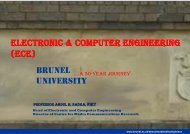DEliverable 2.3 - the School of Engineering and Design - Brunel ...
DEliverable 2.3 - the School of Engineering and Design - Brunel ...
DEliverable 2.3 - the School of Engineering and Design - Brunel ...
You also want an ePaper? Increase the reach of your titles
YUMPU automatically turns print PDFs into web optimized ePapers that Google loves.
ICT Project 3D VIVANT– Deliverable <strong>2.3</strong><br />
Contract no.:<br />
248420<br />
User Acceptance Validation Plan<br />
4 END-USER ACCEPTANCE<br />
The aim <strong>of</strong> <strong>the</strong> user validation with end-users is to determine if <strong>the</strong>y can use <strong>and</strong> enjoy <strong>the</strong> 3D<br />
holoscopic service scenarios envisaged in <strong>the</strong> project. These service scenarios, as described in <strong>the</strong> Use<br />
Cases Document (see Deliverable D2.1), have two main components for <strong>the</strong> end-user: 1) Broadcast<br />
TV, <strong>and</strong> 2) Online Hyperlinking. The validation <strong>of</strong> <strong>the</strong> Broadcast TV component will concentrate on<br />
<strong>the</strong> audiovisual aspects, while <strong>the</strong> validation <strong>of</strong> <strong>the</strong> Online Hyperlinking component will additionally<br />
address <strong>the</strong> interaction <strong>and</strong> scalability aspects <strong>of</strong> <strong>the</strong> service scenarios. The validation will address <strong>the</strong><br />
general acceptability <strong>and</strong> perception <strong>of</strong> <strong>the</strong> service scenarios developed <strong>and</strong> also covers specific issues<br />
derived from <strong>the</strong> end-user requirements in Deliverable D2.1<br />
The focus <strong>of</strong> <strong>the</strong> tests is not to validate 3D Television (TV) per se, but to concentrate on <strong>the</strong> benefits<br />
<strong>and</strong> characteristics <strong>of</strong> 3D holoscopic TV <strong>and</strong> object-based hyperlinked videos.<br />
4.1 BROADCAST EXPERIENCE<br />
4.1.1 Viewing<br />
Specific test criteria for validation by <strong>the</strong> end-user are based primarily on <strong>the</strong> end-user requirements.<br />
This will involve real 3D holoscopic images captured with <strong>the</strong> holoscopic camera <strong>and</strong> computer<br />
generated 3D holoscopic content, or a combination <strong>of</strong> both.<br />
To gain a broad user acceptance some basic requirements concerning <strong>the</strong> picture quality can be<br />
defined as follows:<br />
• Spatial resolution – As broadcasters tend to distribute <strong>the</strong>ir programmes in HDTV format <strong>and</strong><br />
2D, <strong>and</strong> first stereoscopic 3D movies are available on blu-ray discs that use full HD resolution<br />
(1920×1080 pixels), <strong>the</strong> users would expect <strong>the</strong> holoscopic image to deliver similar resolutions. It<br />
has to be investigated if <strong>the</strong> new viewing experience <strong>of</strong> <strong>the</strong> holoscopic image can legitimate<br />
resolutions lower than HD (at least 1280×720).<br />
• Colour – Certainly, colour is a very important parameter to reproduce a realistic image <strong>of</strong> <strong>the</strong><br />
world <strong>and</strong> users will expect pictures which show colours in a most natural way. In order to<br />
investigate to what extent colour representation is a camera or a display issue, computer<br />
generated content could be used for comparison.<br />
To gain a better 3D viewing experience than with existing 3D technologies, <strong>the</strong> user would expect <strong>the</strong><br />
shortcomings <strong>of</strong> stereoscopic <strong>and</strong> auto-stereoscopic technologies to be solved. Basic acceptance<br />
factors will be:<br />
• Free viewing – Like on 2D displays it should be possible for multiple persons to view <strong>the</strong> 3D<br />
holoscopic content without <strong>the</strong> need to wear special glasses <strong>and</strong> independent <strong>of</strong> <strong>the</strong> individual<br />
position in front <strong>of</strong> <strong>the</strong> screen.<br />
• Continuous parallax without distortions – Since current 3D technologies can only provide<br />
horizontal parallax, 3D VIVANT’s holoscopic 3D should deliver full horizontal <strong>and</strong> vertical<br />
parallax throughout <strong>the</strong> viewing zone without flipping or shear distortion.<br />
• Distinguish between 2D <strong>and</strong> 3D content – Because for some use cases a combination <strong>of</strong> 2D <strong>and</strong><br />
3D holoscopic content is needed, users should be able to distinguish between 2D <strong>and</strong> 3D content<br />
without optical or mental irritations <strong>and</strong> be able to watch 2D content on a holoscopic 3D display<br />
without distortion.<br />
During <strong>the</strong> user perception testing <strong>of</strong> <strong>the</strong> Broadcast TV viewing part, users will be asked to view <strong>the</strong><br />
same computer generated 3D holoscopic content that is displayed on different display mediums. The<br />
01.09.11 18
















